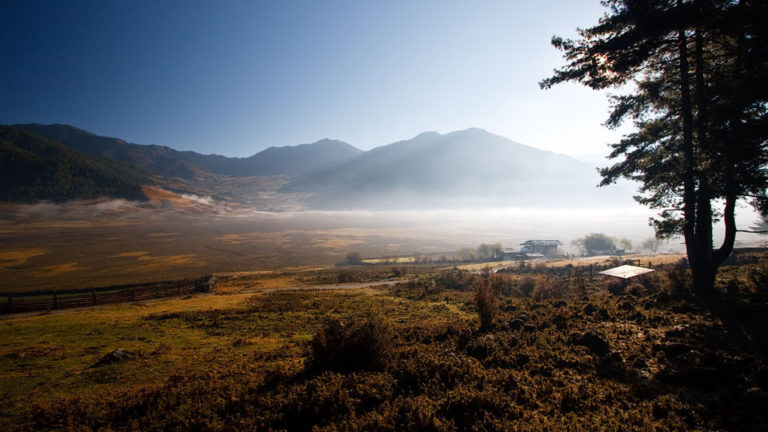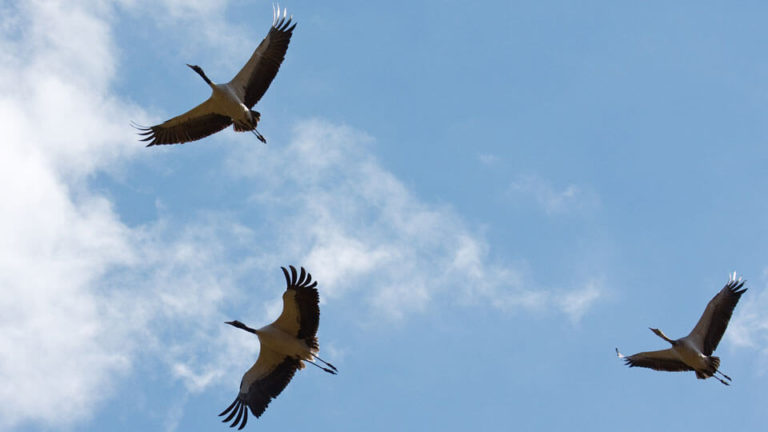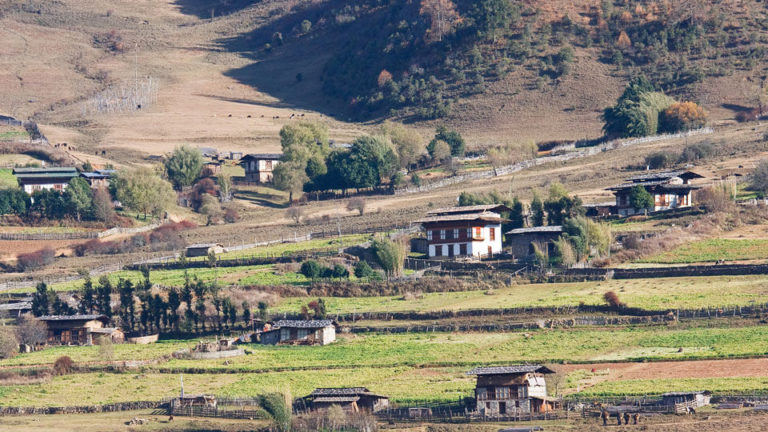Phobjikha Valley: An Oasis of Tranquility
BY TASHI DORJI
PUBLISHED JANUARY 19, 2022 • 5 MIN READ

When I fantasize about exotic destinations, the timeless image of Phobjikha leaps immediately into my mind. Perhaps, visitors to Bhutan could afford to omit most of the famous landmarks from their itinerary, but for all its splendor and well-deserved fame, there is a little known paradise in the country that should not be missed.
At Phobjikha, the culture is a living and breathing part of the present. There is glue that binds the past to create an exciting destination in the world. Time-honored art of living thrives there amid the fast-paced 21st century. It promises travelers a richness of experience to fill a lifetime and provides with a glimpse of 2000 years of colorful history and an eternity of scenic beauty. The best way to really understand Phobjikha is to walk through its different villages that survive between old culture and present atmosphere at every bend of the road.
While humanities students, by the very nature of their subject, spend most of their time poring over books and papers, geographers need to venture into the field to study the actual earth, and at times ‘the field’ takes on a literal meaning.
The following summary of geological accounts of Bhutan provides information about how Phobjikha acquired its present landscape. In Bhutan, Himalayan tethyan rocks are exposed in four isolated sectors:
1. The Northern Higher Himalayan ranges skirting the Bhutan-China border.
2. Near Tremola and Lingzhi in the west
3. The Tangchu-Black Mountain sectors in central Bhutan
4. The Merak-Sakteng sector in the east
Phobjikha valley falls in the third sector of the tethyan sequence and geologically it is a rare section in the entire Himalayan region because this type of tethyan sequence is usually found in the greater Himalayas or above the permanently snow clad mountains of the greater Himalayas and beyond. But Phobjikha valley, which was once an open expanse of water forming a part of the shallow Tethys sea, is found much below the limit and thus its has become a very significant area to be studied. It lies at a lower altitude because of the thrust action which tool place when the Indian plate and the European plate collided. Phobjikha lies between the parallels 27°20’30” North and 27°30’0” North and 90°5’48” East.

Gangtey Goempa, the ancient seat of Pema Lingpa, rests on the ridge top overlooking the verdant meadows of the entire valley. Gyelsey Pema Thinley, the mind incarnation of Pema Lingpa, who did not want to see the Nyingma teaching degenerate or remain precariously like an ephemeral rainbow in the firmament, founded the Goempa in 1613 AD. Kuenga Legpai Dendup, the second reincarnation, later rebuilt it.
The region is delectable, reposeful and inviting. It is not less attractive than the woodland scene, diversified with trees of every growth alike, yet various, which shines distinctively within the twilight of the distant shades. Perhaps, creations of an artist are beautiful, but nature’s work is much lovelier. Amid the sea of this vegetation, the growth of dwarf bamboo is unique to the whole region. The yak, sheep, horses, etc, however, limits their growth to just 40cm.
The Nake Chu flows majestically with a vast expanse of rosary pebbles against an azure sky, threading its way through the lush green valleys, inspiring mountains, and snow-clad peaks, sustaining and incredibly rich culture on its banks. The 29 Km long Naka Chu flows from north to south and joins the Sunkosh river. The blanket of dwarf bamboo plays a salient role in binding the soil from being eroded by this river.
In Phobjikha, the howling wind through the pines is the only sound which keeps you in company, and for many people a condition like this would give rise to feeling of despair and helplessness. But for Phobjis, it sustains peaceful living and provides a carpet which they can dance to the rhythm of change. In fact, they have inherited rom Phobjikha an ancient dream, a song, and a prophecy which they proudly preserve as a gift upon the lap of the valley.

The widest section of the valley houses two groups of people in its embrace – the Draps and the Khaeps. The Khaeps have land on which they struggle to survive, the the Draps are those who got for themselves the best area that the Lhakhang had to offer. They render yeoman service to the Lhakhang. At time, their life was not always decked in holiday attire as they were mere puppets in the hands of the Chief Abbot of the Goempa. Their life, which otherwise would have breathed perfume and glittered in the golden light, was shattered with melancholy.
Potato cultivation, which was earlier meant for self consumption, now finds a way to the market with the construction of feeder road to the valley from Nobding and Pelela. The people’s life now is in transition with the advent of modernization in this valley, which was once upon a time a forgotten paradise. The inhabitants now have access to all the basic amenities that are enjoyed by the rest of the areas in the Kingdom. However, for a keen observer it would not be too hard to notice the metamorphosis, which Phobjikha has undergone with regard to its customs and traditions.
Share this:
Copyright © Bhutan Travel Guru - All Rights Reserved.
